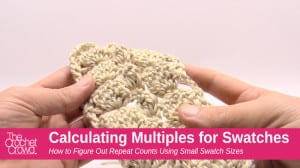2 Ways to Calculate Repeat Patterns

From Small Samples or Swatch Sizes
For small swatch sizes or samples that are fairly small, Mikey shows how to re-create the pattern in diagram format to show what is happening for the stitches. He needs to figure out the multiples so he can start off with the right chain size in the very beginning.
He is using the sample shown in the thumbnail from a written instruction. Before he made the sample, he created the diagram so he could understand the pattern better. It is one of Mikey's personal traits with crochet. He rarely crochets a project blindly without drawing a diagram first.
The pattern used is exactly as shown. It was a strip from an afghan. The stitch is so pretty though, what if the pattern were to be made bigger? The only way to do that is to figure out the multiples.
- With the diagram drawn, he looks for where the stitches begin to repeat each other.
- He takes a copy of the diagram and creates an overlay to see the pattern bigger without having to redraw it bigger.
- He begins the counting process and verifies the counts.
Learn in the below tutorial the steps he took and how he calculated the multiples in order to change this swatch to be a full size afghan if he wished.
Now don't forget, though he calculated the multiples by the end of the tutorial, there is no magic formula for figuring out the yarn required when changing the sizes.

Figuring out the Multiples from Large Afghan Sizes
Mikey primarily uses this method the most in figuring out multiples. Most of the afghans he does usually are for adult sizes but many people request for the afghans to be smaller. The only way to change the sizing is to figure out the multiples so the pattern can repeat and you get the correct chain size from the start.
As you will see in the below video tutorial, he works backwards in reconstructing the diagram without having to draw an entire diagram for the project.
- Mikey starts by drawing the crochet symbols from the row that has the repeat pattern instructions in it. Some patterns, the 1st row could just be a standard single crochet, double crochet or something where all of the stitches are identical. It usually means the pattern's repeat could start in the next row.
- Mikey uses the instructions in the repeat pattern row to give an idea on what the end of the row will look like.
- Mikey then completes the next row after the first one to verify his findings.
- Mikey will then start to go backwards from the start of the 1st row and count the chains back.
- Once the diagram is complete, the stitch locations and counts should be correct. Use the diagram to begin looking at where the stitches repeat.
- Don't forget that there are usually extra chains in a repeat pattern that compensate for the turning chains.
As you will see in the video tutorial below, he shows these above steps in detail in figuring out the afghan that is in the picture.
Ruth Speicher says
How do I down load some of these things. I have a fire kindle and there I as no option on my kindle to do this.
Mikey, The Crochet Crowd says
Our system doesn't work with Kindles as that is a completely different and unique network.
shirley jakonen says
I am just finishing up the woven plaid blanket and I just love it, but I would like to do one in pastel colors and do not know how
to figure out the colors, any help from Diva on this problem, thanks
shirley J.
Melissa says
You must have read my mind. I was going to ask you how to figure out multiples in a pattern and low and behold here it is.
Thank you for being such a wonderful teacher.